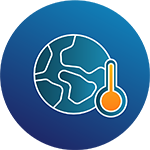
Envoronmental Science
The Interconnectedness of Living Things
Environmental Science integrates natural and social sciences to study how the environment and man-made processes interact with one another. It is an interdisciplinary field that incorporates ecology, chemistry, biology, hydrology, earth and soil sciences, atmospheric science, and natural resource management. In fact, almost every scientific discipline you can think of has a direct relationship to environmental science because the environment is all around us. Environmental scientists need this broad base of knowledge in order to analyze complex environmental issues across multiple perspectives. These complex environmental issues include climate change, conservation, biodiversity, water quality, soil and groundwater contamination, natural resources, waste management, development, disaster reduction, environmental restoration, and various pollutions.[1]
Even though there may be some overlap and often used interchangeably, environmental science should not be confused with environmentalism or ecology. While environmental scientists certainly have the intention of helping to solve environmental problems, as a scientific discipline, it is primarily concerned with describing and explaining the “what and how” of the environment. Therefore, environmental scientists spend most of their time considering the scientific and quantitative aspects of a particular environmental issue. Environmentalism, on the other hand, is a broad philosophical and ideological social movement that intends to enact political, legal, and social change in order to solve environmental problems.[2] While ecologists study organisms and their interactions with each other and the environment, environmental scientists study purely chemical or public health issues that ecologists are unlikely to study.[3]
Silent Spring
While the environment has been studied for as long as science has been around, it is only in the last fifty years or so that it has become an active mainstream field of scientific investigation. The primary factor in the growth of environmental science was the growing public awareness of environmental issues and the need to take action.[4] This growth can be directly traced to the publication of the book Silent Spring by Rachel Carlson. Carlson, a nature author and former marine biologist with the U.S Fish and Wildlife Service, often wrote about the interconnectedness of nature and all living things.[5] In Silent Spring, Carlson wrote about the insidious effect that the pesticide DDT had on the food chain and, consequently, the world’s food supply. The overarching theme of the book, however, was to expose the negative effect that humans had on the environment. So Carlson made a radical proposal: that, at times, technological progress is so fundamentally at odds with natural processes that it must be curtailed.[6] One of the lasting legacies of Silent Spring was legitimizing the field of environmental science, along with ecology, conservation, and environmental protection. Anyone who has an interest in pursuing environmental science should start by reading this very important book.
…
Citations

The Path to Becoming an Environmental Scientist
From High School to Your First Job
Build a Solid Academic Foundation
Basics:
Take all available STEM-related courses (chemistry, biology, physics, computer science, algebra, geometry, calculus) offered at your high school. Take all these classes at the most advanced level possible (honors, AP). This will help you build your knowledge base in scientific theory and concepts.
Recommended:
If not available at your high school, take classes in the various component areas of environmental science – ecology, hydrology, limnology, zoology, oceanography, environmental chemistry, atmospheric science, geology, and soil science – offered online. Also, try and take a course in environmental policy.
Keep in Mind:
Gain lab work experience through a research internship. Learn how to write for a scientific and non-scientific audience. The ability to communicate in writing cannot be overstated. Given the international nature of scientific collaboration, become fluent in a foreign language. Be a voracious reader.
Dive In!
And become an expert
![]()
Peruse our library of must-read books
![]()
Thumb through a scientific publication
Take an online course
![]()
Watch an interesting video
![]()
Check out these great websites
Get a

jump on your Academic career
There’s no substitute for experience.
We have compiled a database of thousands of internships, research opportunities, academic programs and specialized training programs so you can get a jump on your academic career.
Internships
Research
Academic Training Programs
And if you need support to fulfill your dreams and ambitions, our searchable database has plenty of scholarship opportunities as well as programs designed to increase diversity in the sciences.
Scholarships
Diversity, Equity & Inclusion
Need Help Finding Your Opportunity?
Our video tutorials explain the ins and outs of landing a great internship, research project or training program.
Make all the right moves
Advice from those who know
Review current literature to stay abreast of industry advancements
Attend professional conferences and environmental science seminars
Present your research at student research colloquiums
Build experience through internships or as an undergraduate researcher
Have some work experience on your resume
Obtain lab experience and become familiar with lab instrumentation
Gain fieldwork experience
Join professional societies and organizations
Stay current by reading professional and scientific journals
Learn about current research projects
What degree is right for you?

Bachelor’s Degree
A bachelor’s degree is required for all entry-level jobs, but advancement will be limited. Depending on what route you want to take, you should obtain a degree in environmental science or one of its component sciences (chemistry, biology, ecology, oceanography, earth science, atmospheric science). Familiarity with computer modeling, field survey techniques, and scientific instrumentation is essential.
Master’s Degree
A master’s degree is recommended as this is where you will be able to begin to specialize your studies in environmental science. A master’s degree will open up more opportunities with both federal and state government agencies as well as with various companies in the private sector. In a master’s program, you will learn the theory and the practice of environmental science in addition to having the opportunity to engage in fieldwork.
Doctoral Degree
A doctoral degree is generally required if you want to have a career in academia. Those pursuing a doctoral degree would do well to major in a specific natural science, such as chemistry, biology, physics, or geology, rather than obtain a broader environmental science degree. Senior research positions with federal and state government agencies, senior project manager positions with private firms, and high-level positions with nongovernmental and nonprofit organizations may require a doctoral degree.
10 Schools With Excellent Environmental Science Programs
Want to see the full list of colleges and universities with degree offerings or relevant courses?
Environmental Sciences
Duke University
Earth and Environmental Sciences
Columbia University
Environmental Science and Engineering
Harvard University
Environmental Science
The University of Chicago
Environmental Science
Johns Hopkins University
Environmental Sciences
Northwestern University
Environmental Science
University of Florida
Environmental Sciences
University of Wisconsin – Madison
Environmental Sciences
Oregon State University
Environmental Sciences
North Carolina State University
![]()
Tip 1
You should look for an environmental science program with multiple opportunities for independent research and internships so you can learn first-hand about a variety of environments, natural resources, and ecological challenges.
![]()
Tip 2
As corporations strive to reduce their environmental footprint, the demand for environmental scientists will grow. The U.S. Bureau of Labor Statistics predicts that the environmental science field will increase by 8% through 2030.
![]()
Tip 3
Careers in environmental science vary widely from administrative work to fieldwork. You could work in a government agency, manufacturing company, mining firm, or non-governmental organization and at sea, in a laboratory, or even at a zoo.
Have familiarity with one or more of the following areas
![]()
Computer modeling

Field survey and analytical techniques

Satellite imagery

Environmental law

Environmental sample analysis

Environmental governance

Laboratory techniques

Pollution mitigation

Statistical and mathematical methods

Climate change
Typical Job Functions of an Environmental Scientist
Here are some of the interesting things you could be doing.
Determining data collection methods for research projects and investigations.
Supporting environmental compliance efforts.
Reviewing field data and preparing data evaluation reports.
Conducting environmental impact studies and recommending mitigation strategies.
Assisting with site remediation system operations.
Performing soil sampling, water sampling, and community air monitoring.
Developing plans to prevent, control, or fix environmental problems.
Advising government policy officials.
Conducting environmental inspections of businesses.
Assessing the potential environmental effects of development projects.
There’s an Ocean of Possibilities
Environmental scientists use their knowledge of Earth’s systems to protect the environment and human health. Given the wide range of scientific fields that comprise the larger field of environmental science, it is a great choice for someone who wants to have a lot of career options initially and down the road.
Common careers in environmental science include:
- Environmental Scientist
- Environmental Chemist
- Biologist
- Civil Engineer
- Climate Change Analyst
- Ecologist
- Environmental Restoration Planner
- Environmental Engineer
- Health and Safety Manager
- Hydrologist
- Industrial Ecologist
- Sustainability Coordinator
- Teacher or Professor
- Urban or Regional Planner
- Environmental Health and Safety Specialist
- Conservation Land Manager
- Climate Change Analyst
- Soil and Water Conservationist
- Park Ranger
- Wildlife Biologist
- Air Pollution Analyst
- Natural Resource Manager
- Nature Conservation Officer
- Zoologist
- Oceanographer
You’ll also find environment-related niches within more traditional fields, including:
- Environmental Consultant
- Environmental Education
- Environmental Health
- Environmental Justice
- Environmental Law
- Environmental Management
- Environmental Policy
Start your career search with our extensive list of employment websites.
